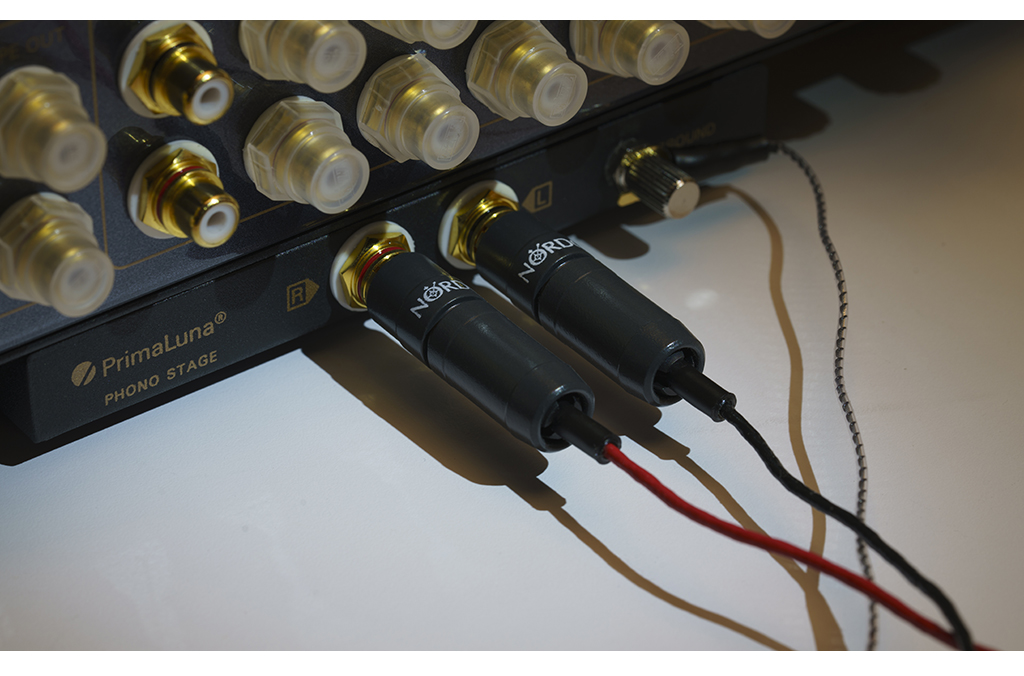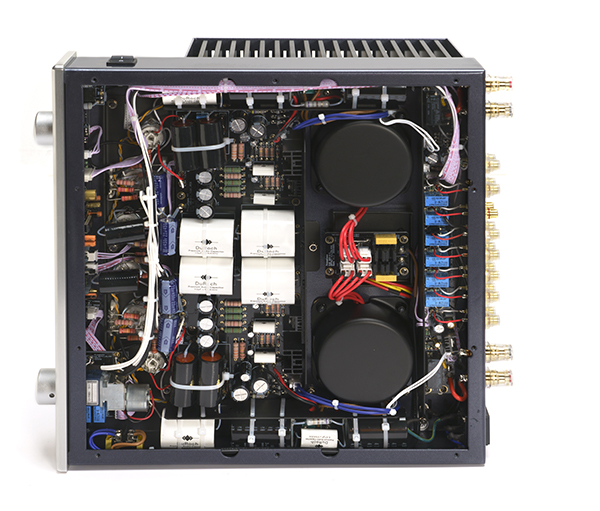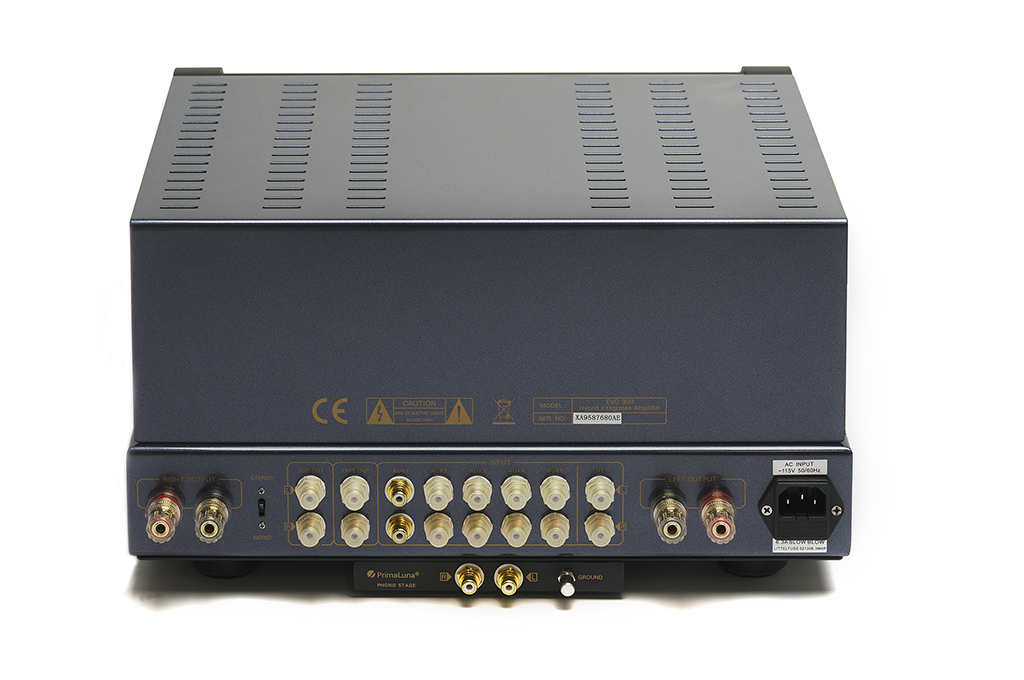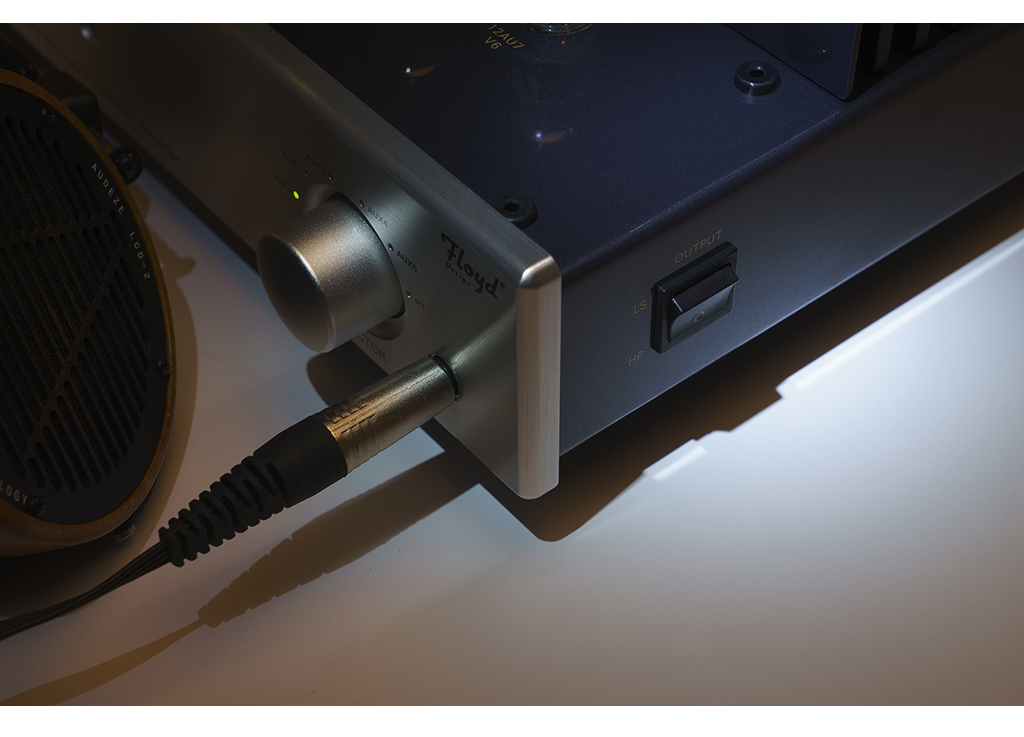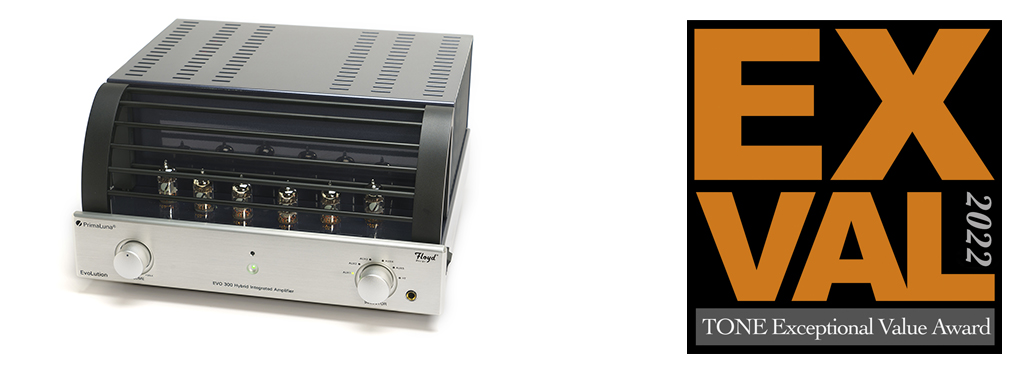The PrimaLuna EVO 300/Floyd Design Integrated All Together Now
By Jeff Dorgay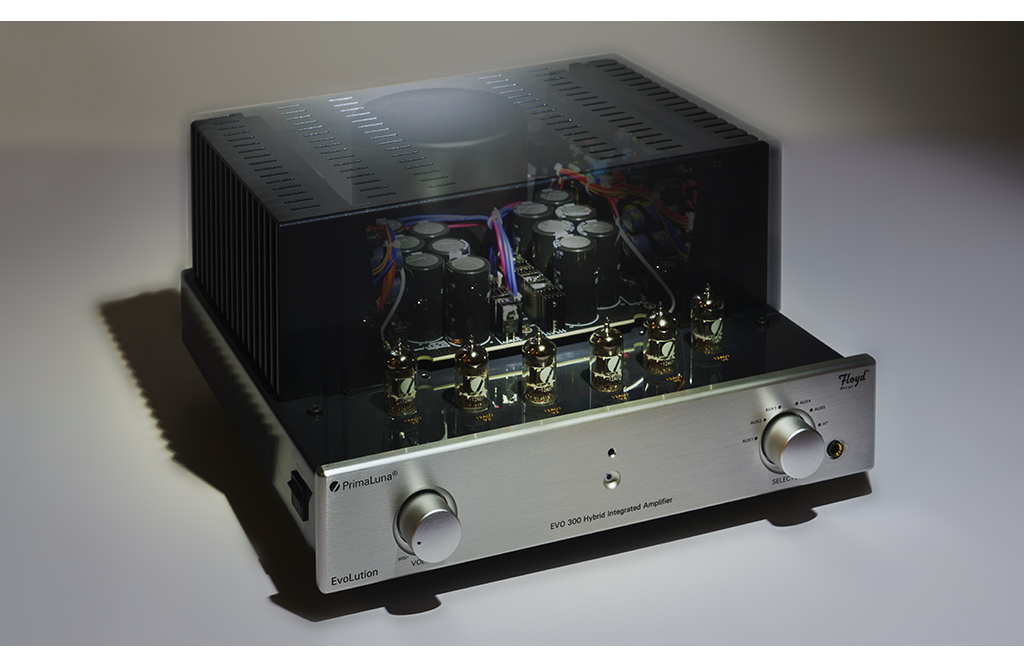 The new PrimaLuna EVO 300/Floyd integrated amplifier begins its journey here with a PrimaLuna EVO 400 power amplifier (loaded with KT150 tubes) beside it on the rack. The dCS Vivaldi ONE has a high-quality variable output stage, making for a perfect front-end component to allow easy comparisons, as the EVO 400 is a power amplifier only. Aimee Mann’s “Humpty Dumpty” gets the evaluation off to a start, as it has on every other review I’ve written in the last 17 years.
The new PrimaLuna EVO 300/Floyd integrated amplifier begins its journey here with a PrimaLuna EVO 400 power amplifier (loaded with KT150 tubes) beside it on the rack. The dCS Vivaldi ONE has a high-quality variable output stage, making for a perfect front-end component to allow easy comparisons, as the EVO 400 is a power amplifier only. Aimee Mann’s “Humpty Dumpty” gets the evaluation off to a start, as it has on every other review I’ve written in the last 17 years.
The MoFi SACD offers a large soundfield in all three dimensions, and Mann’s voice is front, center, large, and breathy. This $7,399 integrated amplifier makes a heck of a first impression. As we’ve had a lot of great integrateds here in the last two years, mainly in the $7,000 – $12,000 range, there is a lot of competition at this price. Some offer onboard phonostages (A high-quality MM phono can be installed in your EVO 300 at the cost of $299, and it’s very good); others concentrate on a built-in DAC. Some have both, others have neither. And they all sound pretty good. There’s a lot of homework to be done. The EVO 300/Floyd leaves the choices to you.
Listening to PrimaLuna’s latest amplifier reminds me of the last time I visited the Louvre. Admiring all the different works of art from such a diverse pool of creativity made me think about amplifiers and how they all sound so different. Measurement geeks that say they all sound the same be damned. Different devices, different topologies all have a different sonic fingerprint. Here, we have something unique.
Your slice of heaven
Possibly one of the most significant discussions we as music lovers have when assembling an audio system is the merits of vacuum tube versus solid-state amplifiers. (And the relative subsets within these categories.) More often than not, tube designs possess an edge when recovering microdynamic information in a recording, and similarly, solid-state amplifiers usually have more current reserve, a higher damping factor, and more control over a speaker’s woofer cone. Hence tighter, more powerful bass response.
Many audiophiles have declared their piece of audio heaven mating a tube preamplifier with a solid-state power amplifier to get the airy delicacy that tubes produce and the extra bass control, dynamics, and current drive of a solid-state power amplifier. While other hybrid designs usually use a pair of tubes as buffer or driver stages to add a bit of warmth, the EVO 300 Floyd brings together a vacuum tube preamplifier and solid-state power amplifier on a single chassis. The result is sheer genius.
Herman van den Dungen, the man behind PrimaLuna, reveals that this hybrid integrated amplifier is designed with a twist. Though it sports a vacuum tube preamplifier section, with six 12AU7 tubes, and a solid-state Mosfet power section, don’t look for a pair of pre-out/power-in jacks on the rear panel. It is not meant to be broken apart into individual sections. On one level, why would you? Both sections have been designed to mate perfectly with the other, and the use of switching or jumpers would only degrade the sound. Tape deck and subwoofer fans fear not, there is a variable output for your sub and a pair of fixed outputs for your reel to reel deck!
As Mosfet devices come the closest to approaching the voice that tubes provide, it’s a natural match, and because there are no output tubes to replace, a re-tube will not be expensive. 12AU7s are plentiful, and even if you feel the urge to roll tubes, NOS 12AU7s aren’t nearly as costly as 12AX7s.
Getting into it
If you’ve never experienced a PrimaLuna amplifier – they are pretty heavy, and well packaged. However, where the EVO 400 all-tube amplifier tips the scale at almost 70 pounds, the EVO 300/Floyd is 55 pounds. Even though the usual massive output transformers are lacking, a dedicated 500VA transformer is on deck for the power amplifier section, and the preamplifier uses a pair of smaller, dedicated power transformers for the tube section.
Removing the bottom cover is a visual feast for the parts geek/aficionado. A cursory look reveals an expensive ALPS volume pot, along with resistors and capacitors from Nichicon, Rubycon, Kemet, Takman, DuRoch, and others. This is the kind of stuff that one usually finds lurking in amplifiers costing 3-5 times as much.
PrimaLuna’s vacuum tube amplifiers are all built with point-to-point wiring (except for the small auto-bias board that eliminates the need to bias the output tubes) and feature a fanatic level of attention to detail. Those arguing point to point wiring can’t compete with the consistency offered by printed circuit boards have never looked inside a PrimaLuna! The EVO 300/Floyd still uses point-to-point wiring, but there are three PCBs now. These boards are 2.4mm thick with 105um gold-plated copper traces, for maximum longevity and highest signal integrity.
Fit and finish elsewhere is equally fantastic. PrimaLuna has always set the standard for execution, using their signature dark blue metallic for the chassis, mated to a thick aluminum front panel with silver or black anodizing. The only thing feeling out of place on recent PrimaLuna products is the control and selector knobs. The rough, pebbly finish does not look as “finished” as the smooth ones used in earlier PL products. This is truly my only complaint with the EVO300/Floyd, but it is something that other PL owners have talked about online. Perhaps offer an upgraded, machined pair of knobs as an add-on?
Around the back, there are five line-level RCA inputs. Unlike the EVO separates, where moving to the 400 series brings balanced capability, the EVO 300 and 300/Floyd only feature RCA inputs. You can only fit so much onto a chassis at some point, and this won’t be a deal-breaker for most.
Finally, PrimaLuna offers a full-function, machined aluminum remote that is again a class leader. You won’t find this level of detail on a nearly $20,000 Audio Research Reference preamplifier. Even better, PrimaLuna’s remote will work with the full range of their components, so if you happen to have an older PL CD player or their EVO DAC (read our review here), you can control everything with one remote. It’s a nice touch that comes with 20 plus years of building components with a human element.
Tomato, tomato?
The EVO 300/Floyd has a rated output of 100 Watts per channel into 8 ohms, and 150 Watts into a 4-ohm load. Early reviews in the UK and European press that are putting it on the test bench reveal closer to 120 Watts into 8 ohms and about 180 into 4 ohms. My EVO 400 reference amplifier delivers 88 Watts per channel and can be switched into triode mode (albeit only producing 50 Watts per channel with KT-150s), offering more flexibility where the ultimate in LF “slam” is not a necessity.
This is more a “different” than a “better” comparison. Listening to both topologies side by side, the lineage is obvious. Thanks to the extra current drive that the hybrid amplifier provides, it will deliver better results with a broader range of speakers. Nothing is off limits with the EVO 300/Floyd. It will even take hold of a pair of Magnepans with ease. HiFi News (and occasional TONE contributor) correspondent Ken Kessler mentions that the EVO 300/Floyd did a great job driving his Wilson Audio DAWs – a speaker that requires a high-quality amplifier.
Carefully listening to tracks with dense mixes and highly layered vocals, such as Todd Rundgren, Crowded House, CSN, and others, shows the hybrid amplifier giving up little quarter to the all-tube EVO yet painting a slightly deeper, more dramatic sound field. Solo acoustic instruments and vocal pieces nod slightly to the tube amp, but heavy rock and large-scale classical pieces favor the Floyd. Again, remember I’m splitting hairs here. This is an incredibly well accomplished product.
Hours of listening underlines what an enjoyable product this is, and at times you might find yourself wanting to lift that top cover to see what’s really in there. We’ve got a pic, so you don’t have to – the EVO 300/Floyd does have a solid-state output stage. PrimaLuna has done a better job combining tubes and transistors on one chassis than anything we’ve come across. This amplifier has not made a single misstep while here. I can’t imagine anyone having buyer’s remorse after taking the plunge. This amplifier has an overall tonality incorporating the inner detail and spaciousness that you would typically associate with an all-tube design.
Feed your head
In addition to adding a MM phonostage, the EVO 300/Floyd sports a ¼” headphone jack on the front panel. You merely need to push the HP/LS switch on the right side to disable the speaker outputs when listening with headphones.
PrimaLuna powers the headphone jack with the full amplifier, so you are not listening to an inexpensive OP amp powered headphone module. Auditioning a wide range of phones on hand from Focal, Grado, and Sennheiser was indeed satisfying. All but the most obsessed headphone listener will not feel the need for an outboard amplifier – further increasing the value proposition or the EVO 300/Floyd.
But why go hybrid?
Telling the story of the EVO300/Floyd on the PrimaLuna home site, van den Dungen (with his usual wry sense of humor) asks the question, “PrimaLuna, what are you doing now?” The answer is complex, but this amplifier is a valuable addition to the PrimaLuna lineup. If you are an audio enthusiast that only wants a vacuum tube setup, PL has you covered. However, if you have a pair of speakers that could use that extra bit of current capability only a solid-state amplifier will deliver, then this amplifier is the perfect solution.
Maybe you’re a tube lover with limited space, or you’re just tired of buying so many tubes. Again, the EVO300/Floyd is the winner. Sonic taste is as wide as the Grand Canyon; you may prefer the hybrid’s voice over anything else. Considering how easy the PrimaLuna amplifiers we’ve owned and reviewed are on tubes, you may never even need to re-tube your EVO300/Floyd. 10,000 hours on a set of 12AU7s in a PrimaLuna or even more wouldn’t surprise me in the least.
As I’ve said many times before in these pages, I love integrated amplifiers because they save you a set of interconnects and a power cord when building a system, making them a supreme value. To that effect, I am thrilled to give the EVO300/Floyd one of our first Exceptional Value Awards of the new year. This is an amplifier you can build a high-performance system around and keep for a long time. Considering that my PrimaLuna ProLogue One is still going strong after 20 years, you can take that one to the bank.
https://www.primaluna-usa.com/primaluna-evo-300-hybrid-integrated-amp
https://www.primaluna.nl/hybrid/evo-300-hybrid-integrated-amplifier/
Peripherals
Digital Source dCS Vivaldi ONE, HiFi Rose 150
Analog Source Technics SL-1200/Denon 103/Pass XP-27
Speakers Sonus faber Stradiveri, Eggleston Nico, Acoustat 2+2
Cable Cardas Clear Relection, Tellurium Q Black II




